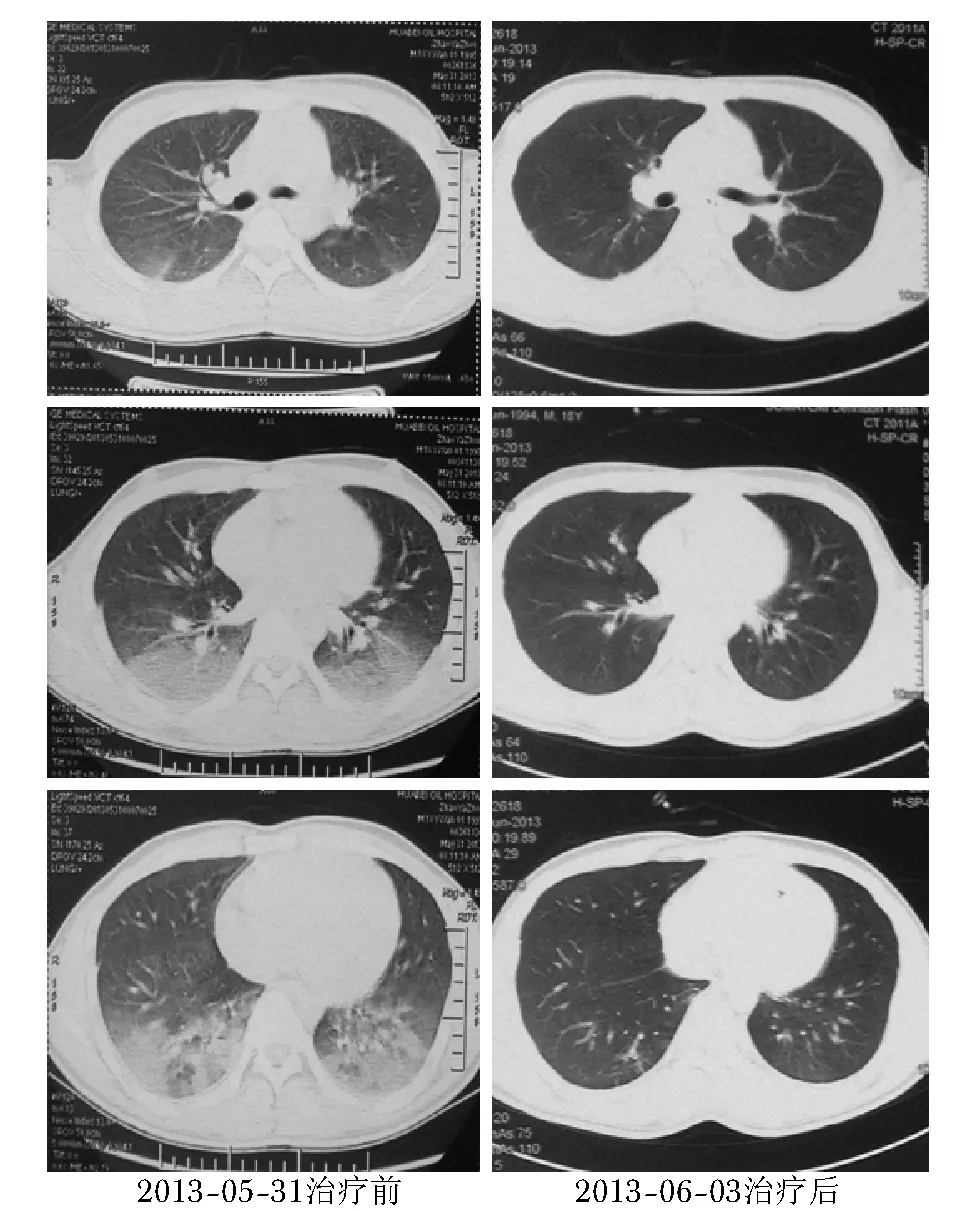人鼻病毒致重症肺炎1例
2014-07-19徐英春
伊 洁,徐 军,徐英春
中国医学科学院 北京协和医学院 北京协和医院 1检验科 2急诊科, 北京 100730
·病例报告·
人鼻病毒致重症肺炎1例
伊 洁1,徐 军2,徐英春1
中国医学科学院 北京协和医学院 北京协和医院1检验科2急诊科, 北京 100730
人鼻病毒;重症肺炎
人鼻病毒(human rhinovirus,HRV)是小核糖核酸病毒科中的一种RAN病毒,因为这种病毒特别适应在鼻腔中生长,故被称为“鼻病毒”。急性呼吸道疾病中30%~50%都与人鼻病毒有关,目前发现人鼻病毒逐渐在下呼吸道感染患者中检测到[1- 2],但主要出现在小婴儿[3],学龄儿童[4],老人[5- 6]和具有慢性疾病、癌症或免疫缺陷及移植后患者中[7- 10]。本文报道北京协和医院收住的1例成人人鼻病毒感染引起的重症肺炎病例。
病例摘要
患者男性,18岁,2013年5月16日无明显诱因出现咳嗽、咳痰,痰为黄色黏痰,伴咽痛,无发热、咯血、头晕、恶心、呕吐,无腹痛、腹泻,就诊于当地医院,给予口服药物治疗,具体不详,症状一度改善。5 d前淋雨后出现咳嗽加重,伴发热、胸闷、呼吸困难,最高体温39.5℃,无寒战、咽痛、肌肉酸痛、胸痛,在当地医院查血常规:白细胞 8.60×109/L,中性粒细胞75%,血红蛋白 160 g/L,血小板 225×109/L。肺部CT检查提示双肺下部大片磨玻璃影,给予头孢类抗生素抗炎治疗,病情逐渐加重,5月31日出现呼吸浅促,尚能平卧,遂转诊于本院急诊抢救。其间呼吸浅促,呼吸频率波动于42~60次/min,吸氧下血氧饱和度98%,心率120~140次/min。病毒筛查甲型、乙型流感病毒抗原均为阴性,为进一步诊治收住院。
入院查体:肺部叩诊双侧为清音,双肺呼吸音粗,右下肺呼吸音弱,可闻及少量爆裂音。血气分析示pH 7.419, 二氧化碳分压37.8 mm Hg,氧分压89.1 mm Hg,血氧饱和度 97.5%;降钙素原(金标法) <0.5 ng/ml。
个人史:生于原籍,久居沧州,否认到过疫区,否认明确毒物接触史,否认吸烟嗜好,否认饮酒嗜好。既往体健。
患者入院当天夜间间断诉喘憋,间断咳嗽、少痰,查体:血压 123/56 mm Hg,心率93次/min,呼吸33次/min,体温38.0 ℃,血氧饱和度 98%(吸氧4 L/min)。入院次日最高体温38.7 ℃,经降温处理后降至37.2 ℃。患者呼吸频率>30次/min,氧合指数195;胸部CT示双肺磨玻璃样改变,重力依赖区成立(图1);血气分析示Ⅰ型呼吸衰竭。重症肺炎诊断成立。患者病情进展迅速,肺内出现实变,采用甲强龙40 mg/d静脉滴注以减轻炎症反应对机体的损伤。6月2日,经甲强龙40 mg/d治疗2 d后,患者咳嗽喘憋症状较前好转,呼吸循环功能平稳。6月3日,患者体温降至36.5 ℃,无明显喘憋,查体心率80次/min,呼吸频率26次/min,血压120/66 mm Hg, 双肺呼吸音粗,右下肺湿啰音消失。胸部CT示双肺磨玻璃影好转,病变明显吸收(图1)。继续甲强龙40 mg/d治疗3 d后,患者病情明显好转。

图 1 胸部CT肺窗比较显示,经治疗双下肺磨玻璃影明显好转,病变明显吸收
病原学检查结果陆续得以回报:痰细菌涂片、真菌涂片均为阴性,痰细菌培养(-),痰真菌培养(-),血培养(-),风疹病毒IgM(-),巨细胞病毒IgM(-),单纯疱疹病毒IgM(-),弓形虫抗体IgM(-),肺炎支原体IgM(-),嗜肺军团菌抗体示IgM(-)、IgG(-),降钙素原<0.5 ng/ml,G试验 25.80 pg/ml,抗中性粒细胞胞浆抗体(IgG型)(-),抗蛋白酶3抗体(IgG型)(-),抗髄性过氧化物酶(IgG型)(-),抗双链DNA抗体(IgG型)(-),抗核抗体(IgG型)(-),血沉5 mm/h。8种呼吸道病毒核酸检测示鼻病毒(+),经测序后确认为人鼻病毒。基本排除细菌、真菌、非典型病原体感染,呼吸道核酸检测提示为人鼻病毒肺炎。
讨 论
在温带地区人鼻病毒全年都可以检测到,9月份有一个高峰,春末又有一个高峰[11]。人鼻病毒感染初始症状轻微且不特异,因此极易被临床医生忽视。本例患者在春末感染人鼻病毒,既往体健,初始症状轻微、不特异,淋雨后病情加重,进展迅速,很快引起呼吸衰竭。胸部CT表现为典型的磨玻璃影,应高度怀疑病毒性肺炎。快速病原学检查尤为重要,应积极排除非典型病原体感染,进行针对性治疗。人鼻病毒是2/3普通感冒的病原体,也有报道是免疫力低下成人或儿童下呼吸道感染的病原体之一[12- 15],但在既往体健成人中引起重症肺炎较为罕见,其机制并不是很清楚,可能与患者免疫状况有关。对于病毒性肺炎的治疗,及时小剂量激素连续使用3~5 d症状即可缓解。病毒性肺炎继发细菌感染也较为常见,应提高警惕。随着病毒感染致重症肺炎病例的不断增多,临床医生应提高对人鼻病毒所致肺炎的警惕,及早明确病因,防止抗生素滥用,同时要掌握呼吸道病毒的流行规律,以助于对疾病有效准确地判断和及时治疗。
[1]Hayden FG. Rhinovirus and the lower respiratory tract[J]. Rev Med Virol, 2004, 14:17- 31.
[2]Papadopoulos NG, Bates PJ, Bardin PG,et al.Rhinoviruses infect the lower airways[J].J Infect Dis, 2000,181:1875- 1884.
[3]Korppi M, Kotaniemi-Syrjänen A, Waris M, et al. Rhinovirus-associated wheezing in infancy: comparison with respiratory syncytial virus bronchiolitis[J]. Pediatr Infect Dis J, 2004,23:995- 999.
[4]Tsolia MN, Psarras S, Bossios A, et al.Etiology of community acquired pneumonia in hospitalized school-age children: evidence for high prevalence of viral infections[J]. Clin Infect Dis, 2004,39:681- 686.
[5]Louie JK, Yagi S, Nelson FA, et al.Rhinovirus outbreak in a long term care facility for elderly persons associated with unusually high mortality[J]. Clin Infect Dis, 2005,41:262- 265.
[6]Nicholson KG, Kent J, Hammersley V, et al. Risk factors for lower respiratory complications of rhinovirus infections in elderly people living in the community: prospective cohort study[J]. BMJ, 1996,313:1119- 1123.
[7]Christensen MS, Nielsen LP, Hasle H. Few but severe viral infections in children with cancer: a prospective RT-PCR and PCR-based 12-month study[J]. Pediatr Blood Cancer, 2005,45:945- 951.
[8]Gutman JA, Peck AJ, Kuypers J, et al. Rhinovirus as a cause of fatal lower respiratory tract infection in adult stem cell transplantation patients: a report of two cases[J].Bone Marrow Transplant, 2007,40:809- 811.
[9]Kumar D, Erdman D, Keshavjee S, et al.Clinical impact of community acquired respiratory viruses on bronchiolitis obliterans after lung transplant[J]. Am J Translant,2005,5:2031- 2036.
[10]Van Kraaij MG, van Elden LJ, van Loon AM, et al. Frequent detection of respiratory viruses in adult recipients of stem cell transplants with the use of real-time polymerase chain reaction, compared with viral culture[J].Clin Infect Dis, 2005,40:662- 669.
[11]Brownlee JW, Turner RB. New developments in the epidemio-logy and clinical spectrum of rhinovirus infections[J].Curr Opin Pediatr, 2008,20:67- 71.
[12]Lauinger IL, Bible JM, Halligan EP,et al.Patient characteristics and severity of human rhinovirus infections in children[J].J Clin Virol,2013,58:216- 220.
[13]Jacobs SE, Soave R, Shore TB,et al.Human rhinovirus infections of the lower respiratory tract in hematopoietic stem cell transplant recipients[J].Transpl Infect Dis, 2013,15:474- 586.
[14]Hong HL, Hong SB, Ko GB,et al.Viral infection is not uncommon in adult patients with severe hospital-acquired pneumonia[J].PLoS One, 2014,4: 95865.
[15]Costa LF, Queiróz DA, Lopes da Silveira H, et al.Human rhinovirus and disease severity in children[J]. Pediatrics, 2014,133: e312-e321.
徐英春 电话:010-69159766, E-mail:xycpumch@139.com
R373.1;R563.1
B
1674-9081(2014)03-0349-03
10.3969/j.issn.1674-9081.2014.03.021
2014- 05- 04)
